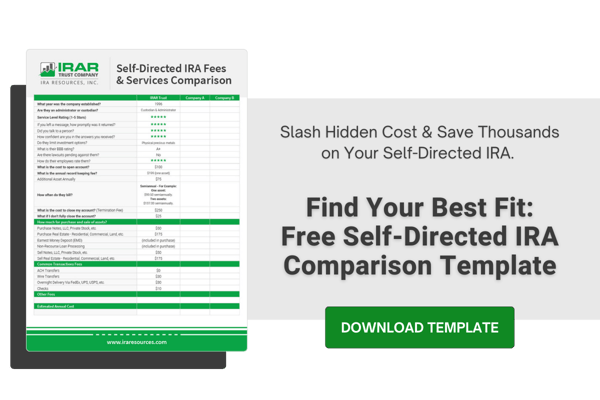How to Take a Distribution or RMD from your Real Estate IRA

Investing in real estate is one of the most popular strategies for IRA Investors. Because of the tax-advantages of rental income, more and more investors are looking to plant their money in physical property. However, once you reach 70 ½ you may be subject to Required Minimum Distributions, or perhaps you have plans for the property in your IRA. To get the property into your name instead of the name of the IRA, you will have to distribute the property— and pay the associated taxes, which often isn’t feasible in one lump sum. We sat down with our experienced Real Estate IRA Experts to get a step-by-step breakdown of this process, as well as some tips to help you best plan your retirement strategy.
Distribution Rules and Requirements
At 59 ½, you can begin to take distributions from a Traditional, SEP or SIMPLE with no additional tax penalty. Before 59 ½, a 10% withdrawal penalty will apply on top of applicable taxes. There are exceptions for certain circumstances (such as unreimbursed medical expenses, higher education expenses, or a first-time home purchase), but this requires a specific waiver from the IRS.
If you have a Traditional, SEP, or SIMPLE IRA, you must start taking Required Minimum Distributions (RMDs) no later than April 1st of the year after you turn 70 ½. If you have a Roth IRA, there is no RMD requirement (since you paid your taxes when contributing to the IRA), though the process for distributing real estate is the same. The amount you are required to take as a Required Minimum Distribution is calculated based on the value of all your retirement accounts, not just the ones held at IRA Resources. If your IRA Resources account holds real estate but you have another retirement account holding cash, you can take your RMD from the cash account without distributing your real estate. No matter your situation, do not forget to take an RMD. If you fail to take an RMD for the year, the amount you were supposed to take as a RMD is taxed at 50%. If you’d like help estimating your RMD, the IRS has some resources. If you do not have enough cash to cover a RMD, you will need to distribute other assets. Here is how you can distribute real estate.
Required Documentation
Requirements vary a bit from provider to provider. At IRA Resources, we require the following to distribute real estate:
- A completed Distribution Form. If you are only partially distributing the property, this must be detailed in the appropriate section.
- A Fair Market Valuation (FMV) Form for the real estate being distributed.
- An appraisal of the real estate to be distributed. This must be performed by a third-party.
- The reregistration document for the property (i.e. an un-recorded deed). This must clearly show full or partial ownership of the asset changing from “IRA Resources FBO [Client]” to the name of the new owner.
Step-By-Step Instructions
Full Distribution of Real Estate
If you are distributing your property all at once, the process is straightforward. Just compile, sign, and submit the paperwork listed above. Your IRA Resources representative will reach out to you if there are additional tasks or steps for you to complete.
Remember— unless you have a Roth IRA and you meet the Roth Rules, you are responsible for the tax on the full value of the asset once you receive the distribution.
Partial Distribution of Real Estate
If you are partially distributing your Real Estate, the process is similar— the main difference is when reregistering the deed or completing any other paperwork, the ownership percentages must be noted. For example, “IRAR FBO John Doe #55-55555 90%, as to the undivided 10% interest John Doe”.
If you plan on distributing your real estate though multiple distributions, the appraisal and reregistration must be completed each time— with updated ownership percentages on the deed. These costs are paid from the IRA, the exact fees depend on the individual county.
Reregistering the Deed
You’ll have to reregister your deed, either fully or partially in your name, when distributing your asset. Requirements vary from county to county, so we suggest reaching out to the county your asset is in for reputable quit claim services. If you’d prefer to find your own resources, a cursory google search should find options in your county. The quit claim deed should spell out any ownership percentages, if applicable. Once you have your quit claim deed, you will forward this to IRA Resources. The deed will need a signature of approval from us, which we will sign on behalf of the IRA, before mailing it back to you. You can then walk the deed to the recorder’s office and file your deed—you’re done!
Remember— You will need to go through this process every time you partially distribute your property, with the updated ownership percentages reflected on the deed.
Relevant: Self-Directed Real Estate IRAs and Taxes: The Basics of UBIT and UDFI
Associated Costs
IRA Resources does not charge for distributions unless you are closing your account, in which case there is a $350 closing fee. The cost to reregister your deed may vary significantly from county to county. You should verify costs with the county in which your property is located.
IRS Reporting
We report Distributions yearly to the IRS on a 1099R form. You will receive a notice from them outlining your tax obligations.
You will have to pay tax on the value of the property you distributed. For example, if your property was worth $100,000 and you distributed 25%, you’d have to pay taxes on 25% of the asset value you distributed (unless you have a Roth IRA— Roth Accounts do not have to pay taxes upon distribution if you meet Roth rules).
Property Taxes
A property tax bill will be sent in the mail, as it was previously. However, when paying these property taxes, you need to remember to pay based on your ownership percentage (for example, if you personally own 10% of the property and your IRA owns 90%, you’d pay 10% of the tax bill and your IRA would pay 90%.
Other Things to Keep in Mind
- Remember: You can take your RMD from any of your IRAs— it does not have to be from your IRA Resources account.
- If you partially distribute your real estate, income and expenses will need to be split according to ownership percentages. If you do multiple distributions with changing percentages, the payment amounts need to adjust each time.
- Make sure you record your quit claim deed. Relevant documents will come to us instead of you and we will reach out to you as necessary. The IRA is still on record as owning the property.
- When distributing real estate, you are required to complete a Fair Market Valuation (FMV) form, along with a third-party appraisal, and submit these to IRA Resources. If you are partially distributing the property, you will need an appraisal each time the property is distributed.
When investing in real estate with your self-directed IRA, getting the details right matters. If you need more information on how to take a distribution from a real estate asset, or have any other questions, give us a call at 888-322-6534. We'd love to help plan for your financial future.









Comments (60)